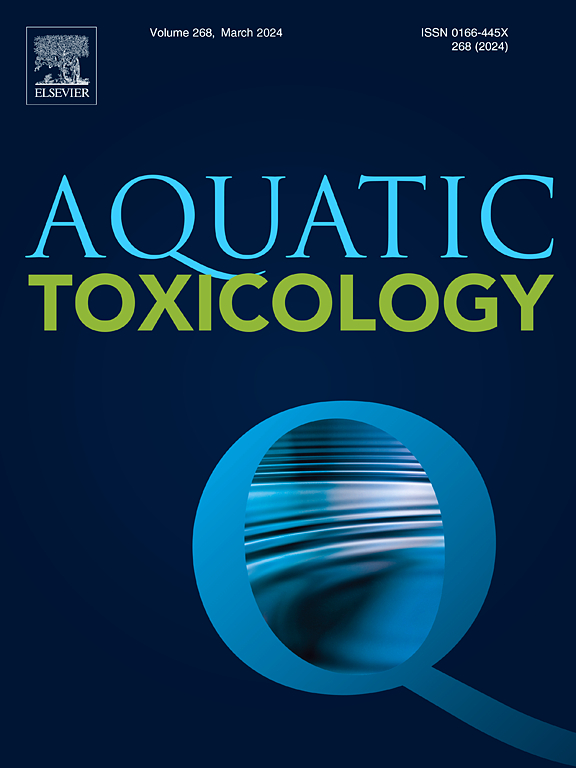离子交换色谱法在金霉素环境污染评估中的应用
IF 4.1
2区 环境科学与生态学
Q1 MARINE & FRESHWATER BIOLOGY
引用次数: 0
摘要
药物等化学物质对环境构成威胁。在土壤和水中记录到的其中一种物质是金霉素,这是一种用于兽医的抗生素。暴露在此类异生物体中的植物会显示出生物胺含量的变化。离子交换色谱分析技术可用于评估其含量。这些活性化合物的出现可用于确定化学物质对环境的污染程度。本研究旨在评估浓度为 0、0.05、0.1、0.2、0.5、1、2、3 和 5 毫摩尔的金霉素(CTC)对受试生物 Lemna minor 的毒性,并确定植物组织中的生物胺含量。生物胺的含量是通过离子交换色谱法和柱后茚三酮衍生化及光度检测进行分析的。Lemna 试验证明,四氯化碳浓度的增加会对植物产生毒性作用。根据计算,0.04 毫摩尔和 0.05 毫摩尔的四氯化碳最低观测效应浓度(LOEC)对 L. minor 的生长和产量具有植物毒性。据测定,组胺、酪胺和尸胺的含量有所增加,在 2.00 mM 四氯化碳浓度下分别达到 1.04、1.90 和 3.10 µg g-1 组织。同时,当药物浓度为 0.10 和 0.50 毫摩尔时,精胺和腐胺的浓度分别增至 1.21 和 3.89 微克/克。相反,研究显示,当四氯化碳浓度为 5 毫摩尔时,植物中的精胺减少了 88%以上。利用离子交换色谱法,对生物胺(尤其是亚精胺和尸胺)进行了分析,结果表明,这些组织内化合物是检测水是否受药物污染的灵敏生物标志物。这项研究证实,Lemna 试验可有效评估四氯化碳的毒性,离子交换色谱法也可用于评估这种抗生素对环境造成的污染。本文章由计算机程序翻译,如有差异,请以英文原文为准。
Ion-exchange chromatography in the assessment of environmental pollution with chlortetracycline
Chemical substances such as drugs pose a threat to the environment. One of the substances recorded in soil and water is chlortetracycline, an antibiotic used in veterinary medicine. Plants exposed to such xenobiotics show changes in the content of biogenic amines. An analytical technique - ion exchange chromatography is used to assess their content. The occurrence of these active compounds is used to determine the degree of environmental pollution with chemical substances. The study aimed to evaluate the toxicity of chlortetracycline (CTC) at concentrations of 0; 0.05; 0.1; 0.2 0.5;1; 2; 3; and 5 mM towards the test organism Lemna minor, and determine the content of biogenic amines in the plant tissues. The content of biogenic amines was analyzed by ion-exchange chromatography with post-column ninhydrin derivatization and photometric detection. The Lemna test proved that increasing concentrations of CTC had a toxic effect on the plants. It was calculated that the Lowest Observed Effects Concentration (LOEC) of CTC at >0.04 mM and >0.05 mM was phytotoxic to L. minor growth and yield. It was determined that the levels of histamine, tyramine, and cadaverine exhibited an increase, reaching 1.04, 1.90, and 3.10 µg g-1 of tissue at 2.00 mM CTC. Simultaneously, spermine and putrescine increased to 1.21 and 3.89 µg g-1 of tissue at concentrations of 0.10 and 0.50 mM of the drug. Conversely, the study revealed an over 88 % reduction in spermidine in plants at 5 mM of CTC. Using ion-exchange chromatography, analysis of biogenic amines, particularly spermidine and cadaverine, highlighted these intra-tissue compounds as sensitive biomarkers for water contamination with the tested drug. This research confirmed that the Lemna test is effective for assessing CTC toxicity and that ion-exchange chromatography is useful for evaluating environmental pollution by this antibiotic.
求助全文
通过发布文献求助,成功后即可免费获取论文全文。
去求助
来源期刊

Aquatic Toxicology
环境科学-毒理学
CiteScore
7.10
自引率
4.40%
发文量
250
审稿时长
56 days
期刊介绍:
Aquatic Toxicology publishes significant contributions that increase the understanding of the impact of harmful substances (including natural and synthetic chemicals) on aquatic organisms and ecosystems.
Aquatic Toxicology considers both laboratory and field studies with a focus on marine/ freshwater environments. We strive to attract high quality original scientific papers, critical reviews and expert opinion papers in the following areas: Effects of harmful substances on molecular, cellular, sub-organismal, organismal, population, community, and ecosystem level; Toxic Mechanisms; Genetic disturbances, transgenerational effects, behavioral and adaptive responses; Impacts of harmful substances on structure, function of and services provided by aquatic ecosystems; Mixture toxicity assessment; Statistical approaches to predict exposure to and hazards of contaminants
The journal also considers manuscripts in other areas, such as the development of innovative concepts, approaches, and methodologies, which promote the wider application of toxicological datasets to the protection of aquatic environments and inform ecological risk assessments and decision making by relevant authorities.
 求助内容:
求助内容: 应助结果提醒方式:
应助结果提醒方式:


